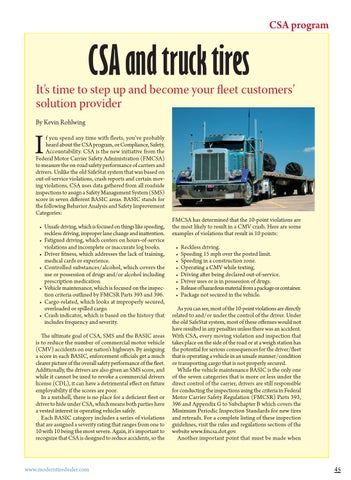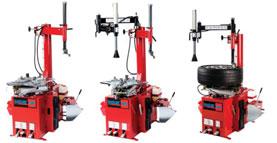CSA program
CSA and truck tires It’s time to step up and become your fleet customers’ solution provider By Kevin Rohlwing
I
f you spend any time with fleets, you’ve probably heard about the CSA program, or Compliance, Safety, Accountability. CSA is the new initiative from the Federal Motor Carrier Safety Administration (FMCSA) to measure the on-road safety performance of carriers and drivers. Unlike the old SafeStat system that was based on out-of-service violations, crash reports and certain moving violations, CSA uses data gathered from all roadside inspections to assign a Safety Management System (SMS) score in seven different BASIC areas. BASIC stands for the following Behavior Analysis and Safety Improvement Categories: • Unsafe driving, which is focused on things like speeding, reckless driving, improper lane change and inattention. • Fatigued driving, which centers on hours-of-service violations and incomplete or inaccurate log books. • Driver fitness, which addresses the lack of training, medical cards or experience. • Controlled substances/alcohol, which covers the use or possession of drugs and/or alcohol including prescription medication. • Vehicle maintenance, which is focused on the inspection criteria outlined by FMCSR Parts 393 and 396. • Cargo-related, which looks at improperly secured, overloaded or spilled cargo. • Crash indicator, which is based on the history that includes frequency and severity. The ultimate goal of CSA, SMS and the BASIC areas is to reduce the number of commercial motor vehicle (CMV) accidents on our nation’s highways. By assigning a score in each BASIC, enforcement officials get a much clearer picture of the overall safety performance of the fleet. Additionally, the drivers are also given an SMS score, and while it cannot be used to revoke a commercial drivers license (CDL), it can have a detrimental effect on future employability if the scores are poor. In a nutshell, there is no place for a deficient fleet or driver to hide under CSA, which means both parties have a vested interest in operating vehicles safely. Each BASIC category includes a series of violations that are assigned a severity rating that ranges from one to 10 with 10 being the most severe. Again, it’s important to recognize that CSA is designed to reduce accidents, so the
www.moderntiredealer.com MTD_41-49.indd 45
FMCSA has determined that the 10-point violations are the most likely to result in a CMV crash. Here are some examples of violations that result in 10 points: • • • • • • • •
Reckless driving. Speeding 15 mph over the posted limit. Speeding in a construction zone. Operating a CMV while texting. Driving after being declared out-of-service. Driver uses or is in possession of drugs. Release of hazardous material from a package or container. Package not secured in the vehicle.
As you can see, most of the 10-point violations are directly related to and/or under the control of the driver. Under the old SafeStat system, most of these offenses would not have resulted in any penalties unless there was an accident. With CSA, every moving violation and inspection that takes place on the side of the road or at a weigh station has the potential for serious consequences for the driver/fleet that is operating a vehicle in an unsafe manner/condition or transporting cargo that is not properly secured. While the vehicle maintenance BASIC is the only one of the seven categories that is more or less under the direct control of the carrier, drivers are still responsible for conducting the inspections using the criteria in Federal Motor Carrier Safety Regulation (FMCSR) Parts 393, 396 and Appendix G to Subchapter B which covers the Minimum Periodic Inspection Standards for new tires and retreads. For a complete listing of these inspection guidelines, visit the rules and regulations sections of the website www.fmcsa.dot.gov. Another important point that must be made when
45 2/14/12 11:13 AM





